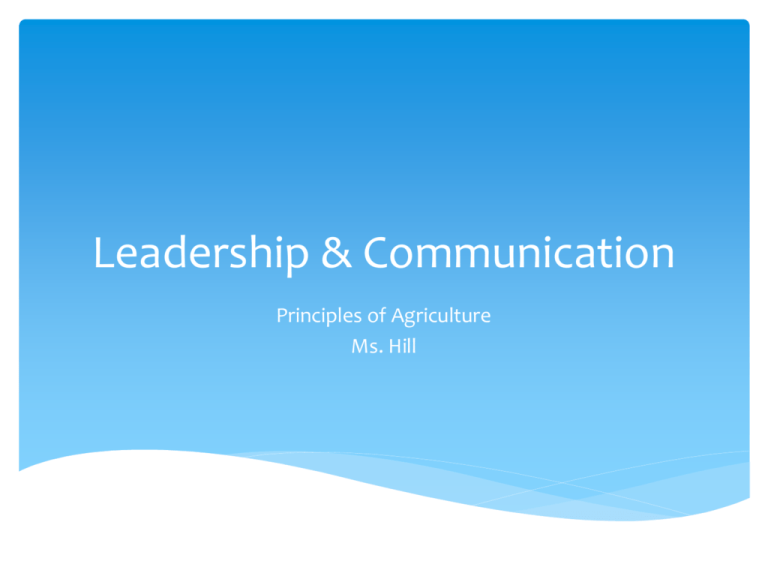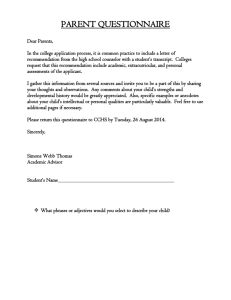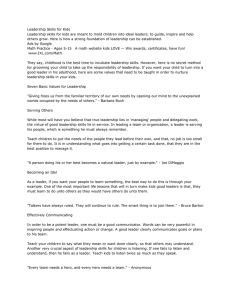Leadership & Communication - NAAE Communities of Practice
advertisement

Leadership & Communication Principles of Agriculture Ms. Hill Objective #1 Define Leadership In your notes… My definition of leadership is… What is Leadership? ACTIVITY! 8 Myths of Leadership 1. In groups of three, discuss each “myth of leadership” 2. Under each myth, write 1 reason why it is true and 1 reason why it is false. 3. Be prepared to discuss these! Objective #2 Describe characteristics of a leader In your notes… 1. Write your name down the left side like this 2. For each letter, write a word that describes YOU! M S. What do you think that many of these words share in common? H I L L Do you think they relate to a particular type of person? All of these words relate to a good leader, and today we will learn about what types of traits these are in relation to leadership. Leadership Characteristics There are four types of leadership characteristics: 1. Internal – personal characteristics Hard-working, driven, creative 2. Technical - these are skills that show you know about leadership and how to do things Follow directions, conduct of meetings, public speaking 3. Conceptual – thinking skills Think logically, anticipate problems, make decisions 4. Interpersonal – people skills Respectful, trustworthy, honest, communication Objective #3 Describe different leadership styles Styles of Leadership Autocratic 1. All decisions are made by one leader. No input from others. 2. Activities directed by authority. The way a task is completed is decided by person in charge. 3. Leader assigns tasks. No choice is given. 4. Leader sets rules, gives praise or criticism, and remains apart from the group. Democratic 1. All decisions are a matter of group discussion, encouraged by the leader. 2. All members are encouraged to share ideas. 3. All members are free to work with whom they choose and on which tasks. 4. Leader is flexible to change and is a regular member of the group. Laissez-Faire 1. Complete freedom of group. No leader participation. 2. Leader supplies info when asked but takes no part in decision or work. 3. Very few comments or ideas are given. Lack of participation is the norm. As a chapter leader, you are faced with getting a sufficient number of volunteers to sell popcorn at the home football games. Which style of leadership do you think would be most effective? In the previous scenario, what possible difficulties might an authoritarian leader face when working with chapter members?? ACTIVITY! To gain a better understanding of YOUR leadership style, we are going to take a leadership style inventory! ACTIVITY! You will be grouped by your respective leadership style as defined by the leadership style inventory. You will be given a mission! It is your job to successfully complete this mission as quickly as possible! Discussion What were the attributes or the positive characteristics of your group? What challenges did you face when working with one another? What strategies did you use to be successful? Why are we concerned with our leadership style? Groups bring together individuals with various decision-making and leadership styles. Understanding how you and others in the group make decisions can help you work with one another more successfully. Objective #4 Discuss the importance of personal leadership development ACTIVITY! Alphabet For Success In your groups, you will be assigned a set of letters from the alphabet. For each letter, choose a characteristic that you feel is necessary in order to achieve success. On construction paper, create a picture of that characteristic to be posted in the Ag hallway. How do you become a successful leader? Analyze yourself, determining your weak and strong points. Set goals for improvement! Make and follow a plan to develop personal leadership skills. Learn how to take directions. Learn about how groups function and identify the types of people within the group. Study the qualities of good leaders and learn from their mistakes. Developing a Personal Leadership Plan 1. 2. 3. 4. 5. 6. 7. 8. 9. 10. Focus your thinking and develop a vision. Set SMART goals. Develop initiative. Develop self-confidence. Develop personal responsibility. Develop a healthy self-image. Develop organization. Eliminate procrastination. Study leadership. Magnify your strengths. In your notes… Develop a personal leadership plan for yourself using the following steps as a guideline. Be prepared to discuss! Objective #5 Explain types of leadership traits, abilities, and skills ACTIVITY! Who’s the leader? I need two volunteers! What two roles must effective leaders achieve in order to provide leadership for their group? Task Role – involves providing direction to the group in order to accomplish the goal. The leader keeps the group moving toward its goal and assists the group in being productive and efficient. Getting the job done is the primary concern in this role. Relationship Role – involves building, enhancing, and maintaining positive relationships within the group. Leaders build cooperation between members and develop the group into a team. ACTIVITY! Ms. Hill is going to give you a questionnaire about “skills”. Answer each question with a “Y” for yes, or an “N” for no. If you answered “yes” in section 1, you have technical skills. These are “how to” skills which are attained the easiest and last the longest. If you answered “yes” in section 2, you have conceptual skills. These are “thinking” skills. They are more difficult to obtain, however, these skills can be developed through thinking games and other activities. If you answered “yes” in section 3, you have human relation skills. These are “people” skills. Most are not hard to learn and can be strengthened through practice and interaction with others. But be careful, leaders tend to forget about these important skills when they’re under pressure to complete a task. On a piece of paper… Write ½ page or more, describing one of the three skills we just discussed. Tell me which you think is the most important and why. Describe a time that you have exhibited this skill or have seen someone else do so. Objective #6 Describe qualities of an effective leader. In previous lessons we have discussed the importance of leadership development, and we have identified the roles and skills which successful leaders achieve. As we have learned, leadership development is an ongoing process. In order for us to be more effective leaders, we can identify qualities of leadership that will help us improve our strengths and eliminate our weaknesses. In your notes… Identify a person that you believe is a successful leader or someone who has had a positive influence in the lives of others. List the qualities of leadership that this person demonstrates or exemplifies. Discussion Who do you recognize as a great leader? What qualities does this person have that make them a great leader? ACTIVITY! In groups of 3, you are going to create a “Top Ten List of Exceptional Leadership Qualities” Be prepared to share these with the class and have these posted throughout the room or in the Ag hallway. Everyone has the potential to develop their personal leadership abilities, since leadership is a process. The best way to learn leadership is to role play situations where you can experience leadership in action. It is critical to your development in becoming an effective leader that you study, analyze yourself, develop, learn, and follow a plan. Objective #7 Describe the four styles of communication. I am going to read off the following list of names. As you hear their names, visualize each of these people. Oprah Winfrey Rosie O’Donnell President Obama Eddie Murphy Dan Rather Each of these people are effective communicators, but each has a very different communication style. In your notes… Let’s take a look at each style of communication. Which style do you think represents… Oprah Dan Rather Rosie O’Donnell Eddie Murphy Which style of communication do you have? I am going to read a list of personalities. As I read each, identify which type of communication that person exemplifies. Also, think about how you would adapt your communication to work more effectively with the person in the scenario. Nancy is a nurse. She is kind hearted, friendly, and easy going. Her patients really like her because she has a soothing effect on them. Relater Norm is an Army general. He gets the job done. When he gives orders, his officers act immediately. Director Bill is a computer genius. He owns his own computer software company. He is rather quiet, but he requires a great deal from his employees. Thinker Rob is a public relations specialist for an agribusiness firm. People enjoy being around him because he has an infectious personality and is always full of energy. Socializer Shirley is a school guidance councelor. Susan really likes her because she always makes time to speak with her. Relater Susan is the State FFA President. Chapters love to invite her to their meetings and activities because she is so outgoing and enthusiastic. Socializer Objective #8 Plan and gather information for a prepared speech. ACTIVITY! TODAY you are going to give a speech on the topic, “The Effects of Foot and Mouth Disease on Livestock Producers in Europe” You will begin presenting in 5 minutes! Just kidding 1. Choose A Topic The first step in preparing a speech is selecting a topic. Choose a topic that interests you! Otherwise, the speech will be more difficult to write and you will become bored. If you are bored, your audience will be bored! Choose a topic which you are knowledgeable about or would like to become knowledgeable about. When presenting a speech, you must have as much knowledge as possible so that your audience in attentive and you can answer questions. Choose a topic that interests your audience. In your notes, brainstorm 3 possible topics for an agriculture related speech. 2. Gather information Find CURRENT information. Possible sources: Books and magazines Breed association publications Trade and business magazines Organizations and expert interviews News articles Government officials and their aides Films/documentaries 3. Record ideas and info Prepare notecards for each resource: Info gathered should include the name of the source, page number, date published/interviewed, author Quotations and statistics should only be used when needed to make a point Objective #9 Write a prepared speech There is one vital step between research of a topic and the delivery of the speech – writing the speech. Because you are presenting a “prepared” speech, the manuscript is very important. It helps you: 1. Recognize the speechs strengths and weaknesses 2. Helps you organize and develop ideas 3. Helps you evaluate grammar 4. Gives you security if you become nervous and forget your speech 5. Helps you stick to a consistent timeline 1. Outline Using your note cards, develop an outline for you speech using the sentence outline style. Speeches should be 3-5 minutes long. 2. Manuscript 1. Body Focus on main points Choose words carefully Always use proper English and grammar 2. Introduction Attention grabber! State purpose 3. Conclusion Remind audience of content Reinforce ideas Leave an impression Objective #10 Deliver a prepared speech Let’s watch a short video… YouTube What made Rick Grisby a good speaker? 1. Practice! The first step in delivering a good speech is PRACTICE! Practice by yourself in front of a mirror. Although it may be awkward, this will help you become more comfortable with the delivery of the speech and with movement. Watch for things you wouldn’t normally do, especially nervous habits. Practice in front of people to build confidence. Practice where you will present. This helps you become more comfortable with your surroundings beforehand. Record and analyze yourself. This will help you identify your strengths and weaknesses, and eliminate bad habits. 2. Memorization is essential Have you ever heard the saying, “Practice how you play”? Reciting a speech over and over is not efficient practice. Once you think you have your speech memorized, you get nervous and forget! You MUST practice like you will present! 3. Question & Answer Session At the end of the FFA Prepared Speech contests and in many public speaking forums, there is a question and answer session. In the CDE, the Q&A lasts 5 minutes. Your responses should be long enough that you answer 3-5 questions within those 5 minutes. Let’s practice!









